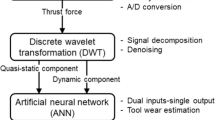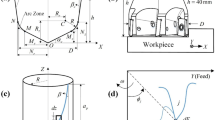Abstract
Signal processing using orthogonal cutting force components for tool condition monitoring has established itself in literature. In the application of single axis strain sensors however a linear combination of cutting force components has to be processed in order to monitor tool wear. This situation may arise when a single axis piezoelectric actuator is simultaneously used as an actuator and a sensor, e.g. its vibration control feedback signal exploited for monitoring purposes. The current paper therefore compares processing of a linear combination of cutting force components to the reference case of processing orthogonal components. Reconstruction of the dynamic force acting at the tool tip from signals obtained during measurements using a strain gauge instrumented tool holder in a turning process is described. An application of this dynamic force signal was simulated on a filter-model of that tool holder that would carry a self-sensing actuator. For comparison of the orthogonal and unidirectional force component tool wear monitoring strategies the same time-delay neural network structure has been applied. Wear-sensitive features are determined by wavelet packet analysis to provide information for tool wear estimation. The probability of a difference less than 5 percentage points between the flank wear estimation errors of above mentioned two processing strategies is at least 95 %. This suggests the viability of simultaneous monitoring and control by using a self-sensing actuator.
Similar content being viewed by others
References
Abouletta O. B., Mádl J. (2001) Surface roughness prediction based on cutting parameters and tool vibrations in turning operations. Journal of Materials Processing Technology 118(1–3): 269–277
Anderson E. H., Hagood N. W. (1994) Simultaneous piezoelectric sensing/actuation: Analysis and application to controlled structures. Journal of Sound and Vibration 174(5): 617–639
Audy J. (2006) An appraisal of techniques and equipment for cutting force measurement. Journal of Zhejiang University-Science A 7((11): 1781–1789
Bahre, D., Rosenberger, U. & Warnecke, G. (1992). Monitoring of cutting processes by vibration analysis: Exemplary applications in grinding and turning processes. Sensors and Signal Processing for Manufacturing; ASME, Production Engineering Division (Publication) (Vol. 55, pp. 65–80).
Balmès, E.& Leclère, J.-M. (2003). Structure dynamics toolbox, for use with MATLAB ®, SDTools, User’s guide version 5.1.
Bonifacio M. E. R., Diniz A. E. (1994) Correlating tool wear, tool life, surface roughness and tool vibration in finish turning with coated carbide tools. Wear 173(1–2): 137–144
Chen S.-G., Ulsoy A. G., Koren Y. (1993) Computational stability analysis of chatter in turning. ASME Dynamic System Control Division Publications 50: 107–111
Cho D.-W., Lee S. J., Chu C. N. (1999) The state of machining process monitoring research in Korea. International Journal of Machine Tools& Manufacture 39: 1697–1715
Choudhury S. K., Bartarya G. (2003) Role of temperature and surface finish in predicting tool wear using neural network and design of experiments. International Journal of Machine Tools& Manufacture 43: 747–753
Del Pino, S., & Pironneau, O. (2008). FreeFEM3D documentation, version 1.0pre11. http://www.freefem.org, May 3, 2012.
Dorf R. C., Bishop R. H. (2005) Modern control systems (10th ed.). Pearson Education, Inc., Upper Saddle River, New Jersey
Frey, P. J. (2001). MEDIT: An interactive visualization software. Institut National de Recherche en Informatique et en Automatique, Rapport technique no 0253, Thème 4.
Freyer B. H., Theron N. J., Heyns P. S. (2008) Simulation of tool vibration control in turning, using a self-sensing actuator. Journal of Vibration and Control 14(7): 999–1019
Gajate A., Haber R., del Toro R., Vega Bustillo A. (2012) Tool wear monitoring using neuro-fuzzy techniques a comparative study in a turning process. Journal of Intelligent Manufacturing 23: 869–882
Geuzaine, C., & Remacle, J.-F. (2009), Gmsh: A three-dimensional finite element mesh generator with built-in pre- and post-processing facilities. International Journal for Numerical Methods in Engineering, 79(11), 1309–1331. http://geuz.org/gmsh/,3.5.2012.
Jackson J. E. (1991) A user’s guide to principal components. Wiley, New York
Jemielniak K., Kwiatkowski L., Wrzosek P. (1998) Diagnosis of tool wear based on cutting forces and acoustic emission measures as inputs to a neural network. Journal of Intelligent Manufacturing 9: 447–455
Li, C.-J., & Ulsoy, A. G. (1999). Precision measurement of tool-tip displacement using strain gages in precision flexible line boring. In American Society of Mechanical Engineers, Dynamic Systems and Control Division (Publication) DSC (Vol. 67, pp. 743–751).
Liu Q., Altintas Y. (1998) On-line monitoring of flank wear in turning with multi-layered feed-forward neural network. International Journal of Machine Tools& Manufacture 39: 1945–1959
Lundholm T., Yngen M., Lindström B. (1988) Advanced process monitoring—A major step towards adaptive control. Robotics and Computer Integrated Manufacturing 4(3-4): 413–421
Mathworks Inc. (2002a). User’s guide of control system toolbox, MATLAB R13. Natick: The MATHWORKS Inc.
Mathworks Inc. (2002b). User’s guide of neural network toolbox, MATLAB R13. Natick: The MATHWORKS Inc.
Mathworks Inc. (2006). User’s guide of wavelet toolbox, MATLAB R2006. Natick: The MATHWORKS Inc.
Mitsubishi. (2007). General catalogue 2007–2008, Mitsubishi Materials, C003B.
Pal S., Heyns P. S., Freyer B. H., Theron N. J., Pal S. K. (2011) Tool wear monitoring and selection of optimal cutting conditions with progressive tool wear effect and input uncertainties. Journal of Intelligent Manufacturing 22(4): 491–504
Pisoni, A. C., Santolini, C., Hauf, D. E., & Dubowsky, S. (1995). Displacements in a vibrating body by strain gauge measurements. In Proceedings of the 13th international modal analysis conference, Nashville, TN, February.
Purushothaman S. (2010) Tool wear monitoring using artificial neural network based on extended Kalman filter weight updation with transformed input patterns. Journal of Intelligent Manufacturing 21: 717–730
Seah K. H. W., Li X., Lee K. S. (1995) The effect of applying coolant on tool wear in metal machining. Journal of Materials Processing Technology 48: 495–501
Scheffer C., Heyns P. S. (2004) An industrial tool wear-monitoring system for interrupted turning. Mechanical Systems and Signal Processing 18: 1219–1242
Scheffer C., Kratz H., Heyns P. S., Klocke F. (2003) Development of a tool wear-monitoring system for hard turning. International Journal of Machine Tools& Manufacture 43: 973–985
Sharma V. S., Sharma S. K., Sharma A. K. (2008) Cutting tool wear estimation for turning. Journal of Intelligent Manufacturing 19: 99–108
Sick B. (2002) On-line and indirect tool wear monitoring in turning with artificial neural networks: A review of more than a decade of research. Mechanical Systems and Signal Processing 16(4): 487–546
Skogestad S., Postlethwaite I. (2001) Multivariable feedback control: Analysis and design. Wiley, Chichester, England
Swantek, S. D., Wicks, A. L., & Wilson, L. T. (2001). SEM proceedings of the 19th international modal analysis conference (IMAC XIX), Orlando, FL, USA, February 5–9.
Vetterli M., Kovačević J. (1995) Wavelets and subband coding. Prentice-Hall, Inc., Englewood Cliffs, New Jersey
Wang X., Wang W., Huang Y., Nguyen N., Krishnakumar K. (2008) Design of neural network-based estimator for tool wear modeling in hard turning. Journal of Intelligent Manufacturing 19: 383–396
Wickerhauser M. V. (1994) Adapted wavelet analysis from theory to software. IEEE Press, Piscataway, New Jersey
Wu Y., Du R. (1996) Feature extraction and assessment using wavelet packets for monitoring of machining processes. Mechanical Systems and Signal Processing 10(1): 29–53
Author information
Authors and Affiliations
Corresponding author
Rights and permissions
About this article
Cite this article
Freyer, B.H., Heyns, P.S. & Theron, N.J. Comparing orthogonal force and unidirectional strain component processing for tool condition monitoring. J Intell Manuf 25, 473–487 (2014). https://doi.org/10.1007/s10845-012-0698-6
Received:
Accepted:
Published:
Issue Date:
DOI: https://doi.org/10.1007/s10845-012-0698-6




